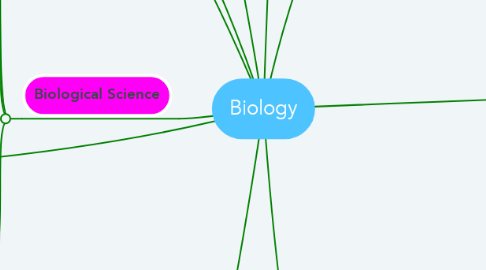
1. HOMEOSTASIS stable inner conditions
2. Cell Cycle
2.1. Interphase
2.2. Prophase
2.3. Metaphase
2.4. Anaphase
2.5. Telophase
2.6. Cytokinesis
3. Biological Science
3.1. Major Branches
3.1.1. BOTANY study of plants
3.1.2. ZOOLOGY study of animals
3.1.3. Ecology
3.1.4. CYTOLOGY study of cells
3.1.5. VIROLOGY study of viruses
3.1.6. PATHOLOGY study of disease causing organisms
3.1.7. ANATOMY study of internal structure
3.1.8. PHYSIOLOGY study of functions & life processes of organisms
3.1.9. MORPHOLOGY study of gross structure of organisma
3.1.10. MYCOLOGY study of fungi
3.1.11. PHYCOLOGY study of algae
3.1.12. ORNITHOLOGY study of birds
3.1.13. HERPETOLOGY study of reptile & amphibians
3.1.14. ICHTHYOLOGY study of fishes
3.1.15. ENTOMOLOGY study of insects
3.1.16. HELMINTHOLOGY study of worms
3.1.17. PARASITOLOGY study of parasites
3.1.18. EVOLUTION study of origin of species
3.2. Characteristics of Life
3.2.1. ALIVE
3.2.1.1. GROWTH and development
3.2.1.2. REPRODUCE offspring
3.2.1.3. HEREDITY of traits
3.2.1.4. METABOLISM energy from Chemical reactions
3.2.1.5. CELLULAR structure & composition
3.2.1.6. RESPOND to the environment
3.3. Levels of Organization
3.3.1. Biosphere
3.3.2. Ecosystem
3.3.3. Community
3.3.4. Population
3.3.5. Organism
3.3.6. Organ System
3.3.7. Organ
3.3.8. Tissue
3.3.9. Cell
3.3.10. Molecule
3.3.11. Atom
4. Cell Biology
4.1. Cell Theory
4.1.1. 1. All living things are composed of cells.
4.1.2. 2. Cells are the basic units of structure and function in living things.
4.1.3. 3. All cells are produced from other cells.
4.2. Types of Cells
4.2.1. Fat cell
4.2.2. Sperm cell
4.2.3. Macrophage
4.2.4. Erythrocytes
4.2.5. Nerve cell
4.2.6. Fibroblasts
4.2.7. Skeletal muscle cell
4.2.8. Smooth muscle cells
4.2.9. Epithelial cells
4.3. Parts of the Cell
4.3.1. CELL MEMBRANE the barriers
4.3.2. NUCLEUS the genetic palace
4.3.3. CYTOPLASM the pool
4.3.4. CYTOSKELETON the framework
4.3.5. MITOCHINDRIA energy system
4.3.6. PLASTIDS the crayons
4.3.7. RIBOSOMES Protein factories
4.3.8. ENDOPLASMIC RETICULUM channels and factories
4.3.9. GOLGI BODIES packaging center
4.3.10. LYSOSOMES the clean up crew
4.3.11. VACUOLE storage tank
4.3.12. CILIA AND FLAGELLA mobility mechanisms
4.4. Cell transport
4.4.1. Passive
4.4.1.1. Diffusion osmosis
4.4.2. Facilitated diffusion
4.4.3. Active
4.4.3.1. Vesicular Transport
4.4.3.1.1. Endocytosis
4.4.3.1.2. Exocytosis
4.4.3.2. Membrane pumps
4.5. Mitosis
4.5.1. Prophase
4.5.2. Metaphase
4.5.3. Anaphase
4.5.4. Telophase
5. Life Processes
5.1. Photosynthesis
5.1.1. Water
5.1.2. Carbon dioxide
5.1.3. Energy
5.1.4. Glucose
5.1.5. Oxygen
5.2. Respiration
5.2.1. Glucose
5.2.2. Oxygen
5.2.3. Water
5.2.4. Carbon dioxide
5.2.5. Energy
6. Genetics
7. Science
7.1. Scientific investigation
7.2. New Topic
8. Taxonomy
8.1. Levels of Classification
8.1.1. DOMAIN eukarya
8.1.2. KINGDOM animalia
8.1.3. PHYLUM chordata
8.1.4. CLASS mammalia
8.1.5. ORDER carnivora
8.1.6. FAMILIA canidae
8.1.7. GENUS vulpes
8.1.8. SPECIES vulpes
8.2. Domains of Life
8.2.1. Common ancestor
8.2.1.1. Bacteria
8.2.1.2. Archaea
8.2.1.3. Eukarya
8.3. Kingdoms of Life
8.3.1. DOMAIN BACTERIA kingdom eubacteria
8.3.2. DOMAIN ARCHAEA kingdom archaebacteria
8.3.3. DOMAIN EUKARYOTA kingdoms animals plants fungus protists
9. Botany
9.1. Plant Systems
9.1.1. Shoot System
9.1.1.1. 1. Above ground
9.1.1.2. 2. Elevates plant above the soil
9.1.1.3. Functions:
9.1.1.3.1. Photosynthesis
9.1.1.3.2. Food and water conduction
9.1.1.3.3. Reproduction and dispersal
9.1.2. Root System
9.1.2.1. 1. Usually underground
9.1.2.2. 2. Anchors the plant in the soil
9.1.2.3. Functions:
9.1.2.3.1. Absorbs and conduct water and nutrients
9.1.2.3.2. Food storage
9.1.2.3.3. Asexual reproduction
9.2. Plant Organs
9.2.1. Leaf
9.2.2. Flower
9.2.3. Stem
9.2.4. Roots
9.3. Modified Organs
9.3.1. Geotropism
9.3.2. Phototropism
9.3.3. Thigmotrophism
9.3.4. Geotropism
9.3.5. Thigmotrophism
10. Ecology
10.1. Feeding Methods
10.1.1. Autotrophy
10.1.1.1. Producers
10.1.1.1.1. Photoautotrophy
10.1.1.1.2. Chemoautotrophy
10.1.2. Heterotrophy
10.1.2.1. Consumers
10.1.2.1.1. Primary eat producers
10.1.2.1.2. Secondary eat other consumers
10.1.2.2. Decomposers
10.1.2.2.1. Detritivores
10.1.2.2.2. Saprotrophs
10.2. Symbiotic Relationships
10.2.1. Mutualism
10.2.1.1. Species A benefits
10.2.1.2. Species B benefits
10.2.2. Commensalism
10.2.2.1. Species A benefits
10.2.2.2. Species B unaffected
10.2.3. Parasitism
10.2.3.1. Species A benefits
10.2.3.2. Species B harmed
